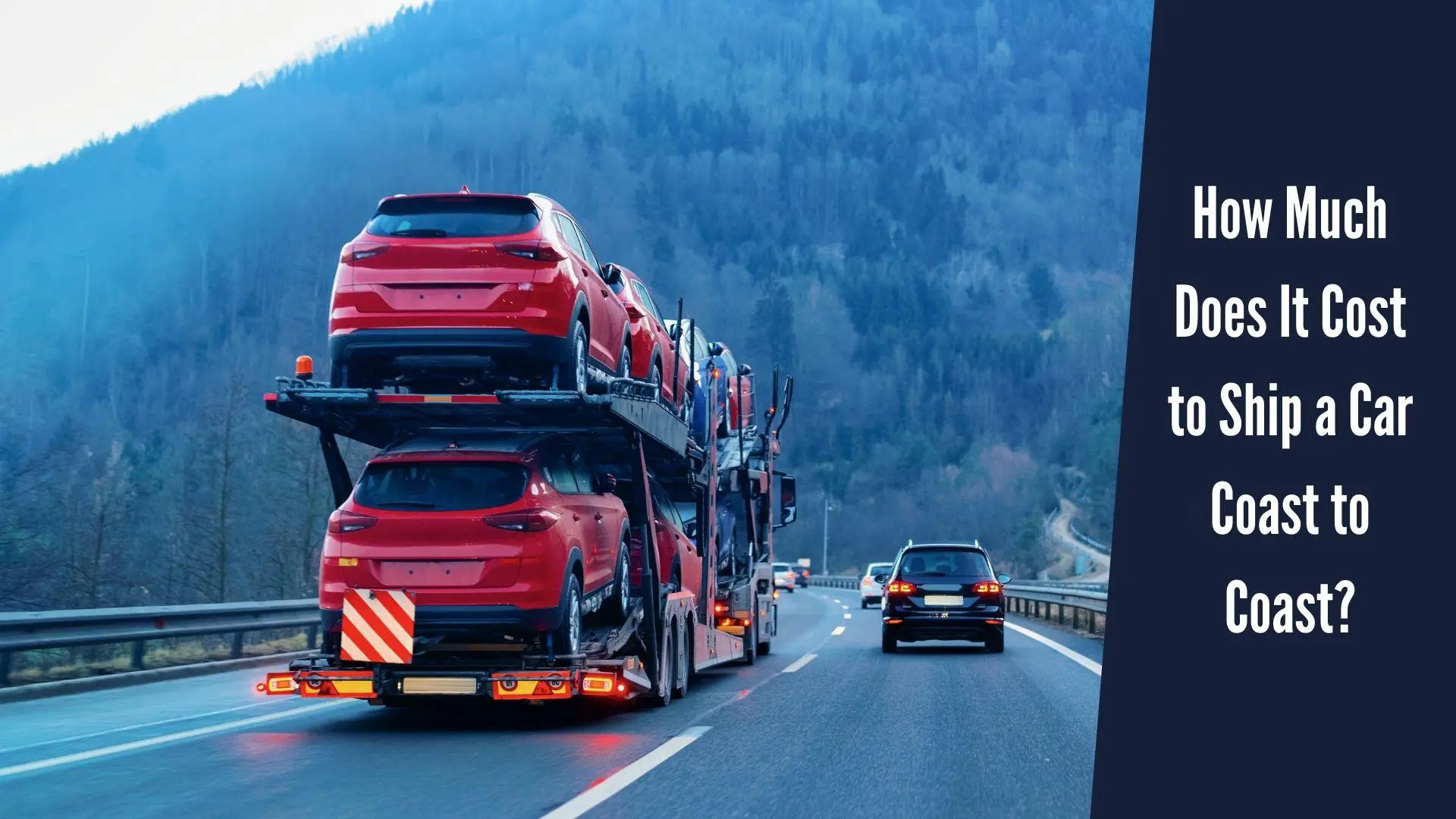Transporting a vehicle from one side of the nation to the other, commonly known as ‘coast to coast’ car shipping, presents a unique set of challenges for both the car owner and the shipping company. Imagine moving from California to New York, a distance of roughly 3,000 miles. Driving this distance would not only be time-consuming but also place unnecessary wear and tear on your vehicle. Conversely, opting to ship a car coast to coast can save you significant time and the potential costs of roadside breakdowns, not to mention meals and overnight stops along the way.
However, several questions may arise before deciding to ship a car from one coast to the other. For instance, you might wonder about the procedures involved in shipping your vehicle, the time it will take, and the safety measures to protect it. You may also be curious about the costs and if there are ways to reduce these expenses. This guide aims to answer these queries, providing a clear picture of what to expect when you opt for coast to coast car transport.
Understanding Coast-to-Coast Car Shipping
Understanding Coast-to-Coast Car Shipping can seem like a tall order, especially when considering the challenges of moving vehicles across the country. Picture this - you’re living in sunny California and landing a dream job in bustling New York! Exciting, right? But wait, you have a stunning classic Mustang that you can’t leave behind. What do you do?
Enter the need for specialized car transport services! These services save the day (and your car!). They’re the superheroes in this narrative, ensuring your prized vehicle makes it from the West Coast to the East Coast without a hitch.
Let’s talk about some of the challenges involved in such a move, shall we? Imagine you decide to drive your car across the country. It’s not just a Sunday drive in the park, my friend! If you’re lucky, you’re looking at a good 40 hours on the road. That’s not factoring in rest stops, meals, and the occasional flat tire. Plus, think about the wear and tear on your beloved car - not a pretty picture.
That’s where auto transport services step in to lend a hand. They have the expertise and equipment to move your car safely and efficiently. Depending on your car needs, they even offer options like open or enclosed transport.
But let’s talk turkey - what about the cost? While it can vary, the coast to coast cost to ship a car can often be less than the cost of driving your car across the country. When you factor in fuel costs, meals, lodging, and potential car repairs, the price tag on a do-it-yourself move can quickly skyrocket.
In contrast, when you ship a car coast to coast, the shipping cost is often more manageable and provides peace of mind. Plus, it saves you time, energy, and unnecessary stress.
Calculating Cost Breakdown for Coast-to-Coast Car Shipping
Wondering how much to ship a car coast to coast? Navigating the intricacies of the cost breakdown involved in coast-to-coast auto transport can often feel like a complex equation. Let’s break it down with a simple example. Suppose you’re looking at a 2,500-mile trip.
Now, running the numbers through the average cost estimator of most car shipping companies, the estimate often falls from $1,000 to $1,250. That’s a ballpark figure, mind you. The exact cost could vary based on vehicle type, shipping method, and seasonal demand.
| From/To | Route Taken | Estimated Cost | Delivery Time |
|---|---|---|---|
| Los Angeles, CA to New York, NY | 2,776 mi via I-40 E | $1,110 | 7-9 Days |
| San Francisco, CA to Miami, FL | 3,045 mi via I-40 E | $1,218 | 8-10 Days |
| Seattle, WA, to Miami, FL | 3,297 mi via I-90 E | $1,318 | 8-10 Days |
| San Diego, CA to New York, NY | 2,759 mi via I-40 E | $1,103 | 7-9 Days |
| Portland, OR to Miami, FL | 3,259 mi via I-80 E | $1,303 | 8-10 Days |
| Seattle, WA, to New York, NY | 2,851 mi via I-94 E | $1,140 | 7-9 Days |
| Los Angeles, CA to Miami, FL | 2,732 mi via I-10 E | $1,092 | 7-9 Days |
| San Francisco, CA to New York, NY | 2,905 mi via I-80 E | $1,162 | 7-9 Days |
| Seattle, WA, to Boston, MA | 3,045 mi via I-94 E | $1,218 | 8-10 Days |
| Los Angeles, CA to Boston, MA | 2,983 mi via I-80 E | $1,193 | 7-9 Days |
| San Diego, CA to Augusta, ME | 3,152 mi via I-40 E | $1,260 | 8-10 Days |
| San Francisco, CA to Boston, MA | 3,099 mi via I-80 E | $1,239 | 8-10 Days |
| Portland, OR to Boston, MA | 3,088 mi via I-80 E | $1,235 | 8-10 Days |
| Las Vegas, NV to Raleigh, NC | 2,330 mi via I-40 E | $1,165 | 6-8 Days |
| Los Angeles, CA to Washington, D.C. | 2,668 mi via I-40 E | $1,067 | 7-9 Days |
| San Diego, CA, to Washington, D.C. | 2,651 mi via I-40 E | $1,060 | 7-9 Days |
| San Francisco, CA to Washington, D.C. | 2,812 mi via I-80 E | $1,124 | 7-9 Days |
| Portland, OR to Washington, D.C. | 2,801 mi via I-84 E | $1,120 | 7-9 Days |
| Los Angeles, CA to Chicago, IL | 2,015 mi via I-80 E | $1,007 | 6-8 Days |
| San Francisco, CA to Chicago, IL | 2,132 mi via I-80 E | $1,066 | 6-8 Days |
| Seattle, WA, to Chicago, IL | 2,064 mi via I-94 E | $1,032 | 6-8 Days |
| Las Vegas, NV to Richmond, VA | 2,405 mi via I-40 E | $1,202 | 6-8 Days |
| Portland, OR to Chicago, IL | 2,121 mi via I-84 E | $1,060 | 6-8 Days |
| Los Angeles, CA to Houston, TX | 1,547 mi via I-10 E | $928 | 5-7 Days |
| San Francisco, CA to Houston, TX | 1,928 mi via I-10 E | $1,156 | 5-7 Days |
| Seattle, WA to Houston, TX | 2,333 mi via I-84 E | $1,166 | 6-8 Days |
| Portland, OR to Houston, TX | 2,267 mi via I-84 E | $1,133 | 6-8 Days |
| Eugene, OR to Trenton, NJ | 2,898 mi via I-80 E | $1,159 | 7-9 Days |
| San Francisco, CA to Atlanta, GA | 2,473 mi via I-40 E | $1,236 | 6-8 Days |
| Seattle, WA to Atlanta, GA | 2,634 mi via I-90 E | $1,053 | 7-9 Days |
| Portland, OR to Atlanta, GA | 2,597 mi via I-84 E | $1,038 | 6-8 Days |
| Los Angeles, CA to Philadelphia, PA | 2,709 mi via I-40 E | $1,083 | 7-9 Days |
| San Francisco, CA to Philadelphia, PA | 2,875 mi via I-80 E | $1,150 | 7-9 Days |
| Seattle, WA, to Philadelphia, PA | 2,821 mi via I-94 E | $1,128 | 7-9 Days |
| San Diego, CA, to Philadelphia, PA | 2,692 mi via I-40 E | $1,076 | 7-9 Days |
| Portland, OR to Philadelphia, PA | 2,864 mi via I-84 E | $1,145 | 7-9 Days |
| Los Angeles, CA to Detroit, MI | 2,280 mi via I-80 E | $1,140 | 6-8 Days |
| San Francisco, CA to Detroit, MI | 2,397 mi via I-80 E | $1,198 | 6-8 Days |
| Seattle, WA, to Detroit, MI | 2,349 mi via I-90 E | $1,174 | 6-8 Days |
| San Diego, CA, to Detroit, MI | 2,342 mi via I-80 E | $1,171 | 6-8 Days |
| Las Vegas, NV to Albany, NY | 2,550 mi via I-80 E | $1,020 | 7-9 Days |
| Anchorage, AK, to Las Vegas, NV | 3,372 mi via I-15 N | $1,348 | 8-10 Days |
| Los Angeles, CA to Annapolis, MD | 2,427 mi via I-70 E | $1,213 | 6-8 Days |
| Charleston, WV, to Las Vegas, NV | 2,099 mi via I-70 E | $1,049 | 6-8 Days |
| Carson City, NV to Columbia, SC | 2,597 mi via I-40 E | $1,038 | 7-9 Days |
| Seattle, WA, to Portsmouth. NH | 3,093 mi via I-94 E | $1,237 | 8-10 Days |
| Lincoln City, OR, to Dover, DE | 2,984 mi via I-84 E | $1,193 | 7-9 Days |
| Harrisburg, PA, to Long Beach, CA | 2,622 mi via I-40 W | $1,048 | 7-9 Days |
| Las Vegas, NV to Providence, RI | 2,700 mi via I-80 E | $1,080 | 7-9 Days |
9 Factors Affecting Coast to Coast Car Shipping Costs!

Fuel Costs
Regarding car shipping, fuel costs are critical in determining the shipping cost. As fuel costs fluctuate, so does the cost of shipping a car. For example, suppose the fuel prices go up in a particular month. In that case, the cost to ship a vehicle may increase correspondingly because the auto transport company needs to cover the additional fuel expenses. So, coast to coast auto transport might be more expensive during times when fuel prices are at their peak.
Service Type (Open or Enclosed)
The type of service you choose, namely open or enclosed transport, is another vital factor. Open transport, where your car is exposed to the elements, is usually the economical option. However, enclosed auto transport provides extra protection against weather and road debris but comes at a premium. If you own a vintage or high-end luxury car, the additional cost of enclosed transport might be a worthy investment.
Additional Services Offered
The type of service selected, such as expedited or standard, can also affect the car shipping cost. If you choose an expedited service, your car will be shipped faster but at a higher price. This service is particularly beneficial if you’re in a hurry and require your car to swiftly be transported to its destination. On the other hand, if you opt for standard service, the cost will be lower, but the transport duration may be longer.
Pickup and Delivery Location
The location of pickup and delivery can dramatically impact the cost. For instance, if you live in a bustling metro area, the transport costs might be lower due to the high traffic volume and easy accessibility. However, the shipping cost can increase if your home is nestled in a remote area. The reason is simple - the transport company must navigate less-traveled routes and perhaps even tricky terrains, which can be time-consuming and require additional effort.
Vehicle Running or Not
Another significant factor affecting the shipping cost is whether your vehicle is operational. If your car is in running condition, it can be driven onto the trailer, which makes the job easier and less costly. However, if the vehicle is non-operational, extra equipment like a forklift may be required to load and unload it, leading to a higher shipping cost. For example, if you have a vintage car that doesn’t run anymore but holds sentimental value, be prepared for an escalated cost to ship it. This is simply due to the additional resources required to ensure its safe and secure transport.
Mileage/Distance
Mileage plays a central role in shaping car shipping quotes. Think of it this way: a trip from Seattle to Miami will require more fuel, more hours on the road, and more significant wear and tear on the transport vehicle than a short jaunt from Philadelphia to New York City. Expectedly, longer distances will push your shipping cost upwards. However, make sure to opt for coast to coast auto transport. Remember, the convenience and safety of having your car delivered right to your doorstep often outweigh the cost involved.
Type of Vehicle and its Size
Moving on, the type and size of your vehicle are paramount in determining the shipping cost. A compact car, for instance, weighs less and takes up less space on the carrier than a hulking SUV or a luxury sedan. Thus, shipping a smaller car is likely to be more economical than sending a larger one. So, if you’re looking to ship a vehicle on the larger end of the scale, brace yourself for a slightly heftier bill.
Weather Conditions
Weather conditions can also influence car shipping costs. For instance, harsh winter conditions could slow transport, increasing costs due to longer transit times. Similarly, a route plagued by frequent storms might require a higher fee for the added risks and potential delays. So, before you schedule your shipment, take a moment to consider Mother Nature’s potential impact on the shipping cost.
Time of Year
Finally, the time of year you ship your car can also affect the cost. For instance, summer is typically a high-demand auto transport season, which could increase prices. On the other hand, you might find cheaper rates during the slower winter months. However, keep in mind that the weather conditions during winter might also affect transport times and costs. So, it’s all about finding that sweet spot between price and convenience.
Shorter vs. Longer Distances and Cost Variations
A longer distance automatically translates to a higher cost to ship a car. However, it can be more complicated. Distance plays the main role in the cost to ship a car, but it’s not the only determinant.
For instance, the price could be higher if you’re shipping a car over a shorter distance, but carriers only sometimes service the route. On the contrary, your coast to coast auto transport may cover a greater distance, but if carriers frequently travel the route, the cost per mile could be lower.
Thus, the ultimate shipping cost isn’t purely a distance game; it’s about finding the perfect balance between distance, route frequency, and timing.
Tips to Save on Car Shipping Costs
- Begin with the concept of terminal-to-terminal delivery , a method that can significantly reduce your car shipping expenses. Imagine you’re shipping your car coast to coast. Rather than paying for a premium door-to-door delivery service, opt for terminal-to-terminal delivery. This means you drop off your car at a designated location (the terminal), then shipped to a terminal close to your destination. You, or an appointed person, would then pick up the car from there. This option is often cheaper because it reduces the shipping company’s time and fuel costs.
- Next, consider timing your shipment during off-peak seasons. Much like air travel, car shipping prices can fluctuate based on demand. For instance, shipping prices can escalate when many people move or travel during summer and winter holidays. You can take advantage of lower rates by planning your car shipment during off-peak times. Suppose you’re relocating from the East to the West Coast during autumn. That’s an ideal time to ship a car, as demand for car shipping is generally lower during this season.
- Look into the discounts offered by shipping companies. Easy Auto Ship, for instance, extends discounts to AAA members, military personnel, snowbirds, and those shipping multiple cars. These discounts can significantly cut down your coast to coast car shipping costs. For example, if you’re a military personnel moving from one base to another, you could save a substantial amount on your car shipping expenses.
- Providing complete and accurate details is another critical factor in saving on car shipping costs. This includes information about pickup and drop-off locations, the car’s weight and dimensions, and any modifications. Only complete or correct details can lead to accurate quotes, and you might face unexpected charges when the final bill arrives. For instance, if you fail to disclose that your car has an aftermarket lift kit, you may be surprised with additional fees, as modifications like this can affect the shipping logistics.
- The day you choose to book can also impact your shipping costs. While it might seem insignificant, choosing a weekday for your car to be picked up could save you money. Carriers often charge more for weekend pickups due to increased demand. If you’re shipping your car coast to coast, the savings from choosing a weekday pickup could add up.
- Finally, flexibility with delivery dates can be vital in cost-saving. If you don’t need your car immediately upon arrival at your new location, allowing for a delivery window rather than a specific date can lower costs. Carriers often consolidate shipments going in the same direction to maximize efficiency. By providing a delivery window, you give the carrier flexibility to optimize their route, which can result in lower costs for you. If you’re flexible with your delivery dates, you can keep your car shipping costs to a minimum.
Parting Words: Making Informed Choices for Coast-to-Coast Car Shipping
Balancing cost considerations with service quality is an art when you ship a car. It’s like trying to walk on a tightrope. You need to get the best out of your buck, but not at the expense of service quality. Imagine you’re a collector of vintage cars, and you’ve just procured a 1961 Jaguar E-Type. Would you entrust this beauty to a shipping company offering rock-bottom prices but with a track record of late deliveries and damage complaints? Likely not. That’s why finding a middle ground where cost and quality meet is essential.
The next step is initiating contact with reputable car transport companies for quotes to ship a car. Your goal is to get the best deal for your car shipping needs. For instance, you could contact Easy Auto Ship, as we’re known for our transparent pricing and top-notch service to ship a car. Remember, the cheapest quote might only sometimes be the best. Look beyond the numbers and evaluate the company’s reputation, customer service, and reliability.





